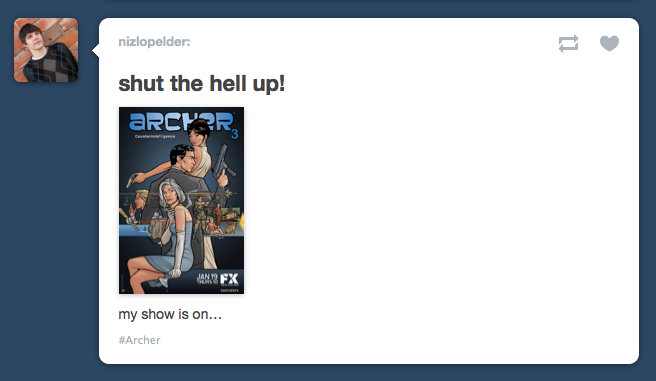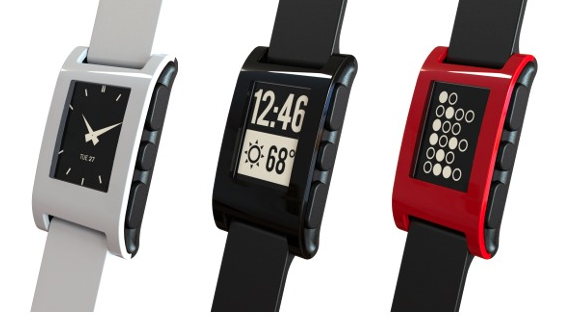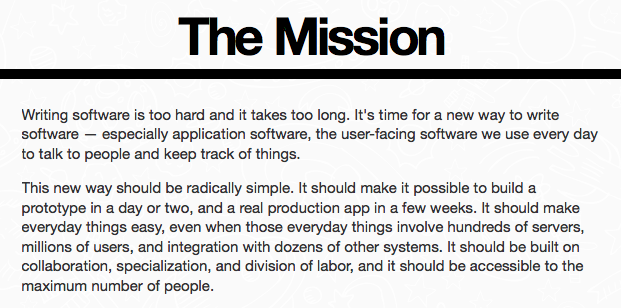April 20th, 2012
Highly recommend the Peter Thiel video from the Pando Monthly event last night.
One quote from Thiel that really stuck out:
“I don’t think it makes sense to be contrarian [just] to be contrarian. That assumes that people have well defined views. That’s one of the things that has shifted — people don’t have real opinions anymore.”
Some thought questions:
How is it that we have, according to Thiel, lost these well-defined views that apparently were once ubiquitous?
Does the digital dissemination of information and opinion mean that we are less likely to develop our own opinions, and more likely to just steal soundbytes from someone else?
Or rather is it that there’s so many opinions floating around that we prevent ourselves from developing anything deep and well-defined because we are too busy shuffling from one to the next?
While there’s certainly a ton of me-too thinking pervasive in technology (and a ton of other industries), I am struggling to think about it as a “new” phenomenon. Has it become particularly pronounced over the past 15 years as the technology startup world has grown and become more mainstream?
What’s interesting though is that if you’re a contrarian and you’re right, and the world actually does shift in the way you say it is going to, how do you keep it up?
April 19th, 2012
Did you hear the one about how Paypal started as a P2P (peer-to-peer) mobile payments company for Palm Pilots? The central concept was the same as most P2P mobile payments companies: you’re sitting at a restaurant with a group and the check comes and HOW do you split it, so stressful, OMG.
Yet when Paypal realized (circa 1998) that everyone sitting at the table needed a Palm Pilot to participate in their mobile payment revolution, and that scenario would happen probably almost never (only ballers had Palm Pilots back then, remember), they scrapped the idea.
But it is now 2012, and P2P mobile payments are BACK with a vengeance. But who will be the big winner? I think it’s still anyone’s game.
Let’s return to the dinner scenario. I had some people over for dinner a few weeks ago, and a friend was going to take a cab home but had no cash. Not to worry, says me! I whipped out my Square. And this girl looked at me stupefied as I took out the dongle, swiped her card, and handed her $20. I figured Square was like so 2010, but I am realizing now that although Square definitely owns it at Flea Markets, it hasn’t *really* penetrated the Dinner Table yet.
I then showed my friends Venmo, and the reaction was similar. Because SMS is the delivery mechanism, Venmo prompts even more disbelief – there’s no tangible action whatsoever.
While Paypal is big enough now to have penetrated the mainstream, I wonder who will be the real winner of P2P mobile payments – that holy grail of dinner-table-transactions.

Here are the main contenders:
1. Square: Beautiful and seamless experience, emailed receipts are amazing and you only need one and not everyone at the table needs an account, just a credit card. But a dongle can’t fit in your wallet. To me that’s a dealbreaker.
2. Venmo: Uses extremely popular existing platform (SMS). Though I think the mental chasm of “sending money through text message” is going to be tough to tackle. If they can get past that, it’s a great product.
3. Dwolla: The wildcard. They don’t have a P2P mobile app that I know about, though I am sure there’s likely one in the works. They do an excellent job of branding and user education, which is why I think they are the sleeper contender here.
4. Bump/Paypal: Everyone knows Bump and everyone knows Paypal. But there’s serious, serious rage (both on the web and IRL) centered around Paypal, so much so that I bet negative paypal-related domains (paypalblows.com, etc.) are fetching some pretty serious coin on the domain message boards these days. If Bump made their own payments app, I think it would be pretty sweet. Here’s hoping.
5. Bitcoin: JK.
Imagine trying to explain Bitcoin to _________ (fill in the name of anyone you know who isn’t an uber-nerd).
The winner of the Dinner Table Challenge will take a sizable slice of a likely many-billion-dollar market. But the real prize is a chance to penetrate the $$$-related zeitgeist. Can you imagine – a Square in a rap video? Beyonce and her Blackberry Venmo-ing?
Soon.
April 18th, 2012
Rap Genius can now count itself among only a small handful of startups where a member of the community (as in, someone who isn’t a founder or employee) has ink related to the startup.

Now, even if Monster Mike’s new tattoo is a fake, I would argue that this is still kickass for RG. The site isn’t just crushing their original goal of bringing the nuances of rap lyrics to the masses, but that their community is getting stronger and stronger with every song that gets decoded.
Superfans are so, so important to any community endeavor – those few people who will put your stickers on bathroom walls and tell their friends to get an account. The ones who will spend hours on your site, making it better for every new visitor that arrives. As a founder (like Tom Lehman) or an employee there’s only so many people you can reach every day – superfans help to spread the word in a way that you as a founder maybe can’t. While 1 guy getting a tatt isn’t the same as other “metrics” like month-on-month traffic growth, I would argue that it is maybe more significant.
This is just the beginning for this burgeoning empire of swag that is Rap Genius. Once you get the community dynamics just right, even on the most micro scale, the community will build on itself, weaning its way into the zeitgeist and never looking back.
April 17th, 2012

People use the phrase “MY SHOW” for a reason, and have this weird possessive relationship with television shows that as far as I can tell doesn’t really exist with movies. Yet the potential of this sort of possessive/obsessive behavior isn’t fully realized with existing digital distribution strategies.
Let’s take the hypothetical situation of a not-super-popular network television show on the night it airs (unlike Archer mentioned above, which is super popular). Sometimes shows like this aren’t on Hulu or Netflix and the network certainly isn’t giving it away for free on YouTube as a promotional giveaway because the upside isn’t really there. But for someone, this is their show. It usually takes time to get it on iTunes (very hit or miss) and sometimes it’s not available there either, or the entire season is dumped at the end of the season’s run.
At this point, people will turn to torrent sites (torrenting sites?) or streaming sites, who have somehow grasped that the desire to watch/catch-up is highest in the 30 seconds after the show airs and falls precipitously afterward. This is based on entirely anecdotal gut-feelings, though surely there have been studies have been done on this topic. DVR wonderfully took advantage of the behavior described above, but in this new digital universe even DVR just isn’t quite the answer any more.
What I really want is a site like Gumroad to power this instantaneous knee-jerk desire to see my show ASAP. Gumroad is an interesting new platform that allows people an easy way to sell digital goods and collect payments, and it would be nice to know that everything is there and available for immediate purchase.
If Gumroad doesn’t do it, another option is that anyone can easily build a site powered by Gumroad that sells digital content instantaneously (where GR acts as the platform). People might even pay a premium. Night it comes out? Then it’s $2.50, and goes down to $1.99 the next day.
Pricing and monetizing digital content is one of the most fascinating future-of-the-web topics to me right now because the world of digital content is maturing. I think Gumroad has come up with a very compelling product that could contribute in a meaningful way if properly embraced, and I am excited to watch their progress.
April 16th, 2012
Saw this really amazing iPad mount over the weekend and forgot to snap a photo.
Luckily, I was able to find a similar photo on the interwebs. It looked a bit like this:

Now, iPad/tablet mounts aren’t exactly new, but they are getting more and more tricked out and awesome. Mounts are just the beginning, and seeing it all rigged up like that got me thinking about all the things I wanted MY mounted iPad to control in my apartment (“house” is a bit of wishful thinking, whatevs). This is part Back to the Future II, part actually possible.
1. Control the temperature — Obvious, and coming soon.
2. Control the music — Is airfoil available on the iPad? I assume the best bet here is Sonos though I imagine the home-entertainment-via-tablet market is going to grow a lot over the next 5-10 years.
3. Control the garage door and start my car for me — Not that I have a garage! But seems like that might be kind of cool for all you car-lovers.
4. Order delivery food — Knows past orders, nearby places, hours.
5. Control my television — Discovery + actual channel-changing.
6. Be my smoke alarm — Not sure if this is technically possible, but this is a wish-list, remember.
7. Personal data portal — Included here: tracks diet, home products, exercise/health stats, travel, sleep patterns. Basically every personal-data-related startup in a single app.
8. PRINT STUFF – directions, articles, grocery lists, recipes, etc.
Obviously each of these things warrants its own post. Expect that soon.
April 15th, 2012
Just a quick note about Kickstarter and the Pebble watch.

Given everything out there about Kickstarter’s founding story one gets the impression that the crux of its existence revolves around art and creativity. Just a guess based on that huge banner on their home page. Funding a rock concert in New Orleans and all that. Novellas, art projects, letters, albums, tours, Girl Walk, etc.
Up for debate whether consumer electronics fits in this category. Ask someone in 2006 and the answer is likely “HELL TO THE NO”, especially in the years before Apple (and their design-conquers-all attitude) was the most respected brand in the world of consumer electronics, which pre-iPhone they def. were not.
Back to the Pebble watch. Consumer electronics are among the most well-funded projects on Kickstarter despite the fact that it’s dubious whether they should even be included in the scope of fundable projects. Which is really fascinating because that to me means that consumer electronics as a market has been ripe for disruption all along. That said, it’s ridiculously not obvious that disruption would come from the same place that allows an artist with a sharpie, a hotel room and a webcam a way to make the art she wants.
I guess the big lesson here is that you can have a secret plan to disrupt one market (how creativity is funded) and end up making an arguably even larger splash in another one (consumer electronics r&d, marketing, sales, business models, etc.) Was this part of Kickstarter’s plan all along? Obviously there’s no way to tell, but my guess is probably not.
Making consumer electronics has, as far as I can tell, not *really* been considered a creative way to spend your time until maybe right now. In 2009 I did a ton of research on making a totally awesome mini-projector (thesis: smart phones would soon be everywhere, and the only downside is the lack of screen real estate). I was basically told over and over again that I would get undercut by someone doing it cheaper who already has a standing deal with Best Buy, would get shoved out of the market, and go bankrupt doing so because of the overhead that accompanies “hardware startups”.
So good on you kind citizens of the internet for saying eff that. Give us devices that are smart and beautiful and carefully crafted and we will throw literally millions at them overnight.
April 14th, 2012
The proliferation of different devices that have entered our lives over the past 5 years has created one of the greatest product challenges of our time: cross-device compatibility. This is both a design challenge as well as a technology challenge, and an extremely new and difficult problem to solve. Products that even attempt multiple interfaces are very much ahead of the curve, and I wanted to highlight 4 apps I use pretty often that do syncing extremely well.
1. SPARROW.
I mostly use Sparrow for email – have been using the iPhone app since it came out, and use the Mac Desktop client as my primary email application. Use the default “Mail” on the iPad and Gmail’s web app every now and then. This presents a fairly potent challenge for Sparrow because they are a 3rd party application and not hosting the original emails.
That said, despite these core challenges Sparrow does a great job of syncing. There have been hiccups related to the address book syncing and message syncing back to Gmail, though those have been slowly fixed in recent updates.
2. RDIO.
I love Rdio and listen to it often on my laptop, which is great. I pay $9.99 a month for it, making it the most expensive of the 4 apps listed here. I get it that like $9.98 of that goes to the record companies, but still, it’s pricey. I also use Rdio quite a bit on the subway, where more often than not I have no service.
This is where I run into syncing issues, possibly the most severe and annoying of the 4 apps listed here. Their mobile sync is extremely slow and arduous. Perhaps it’s because music files are quite a bit larger than email/text/tweets, but my playlists will often disappear when I am offline and even when I am on wifi the sync is time-consuming.
3. TWITTER.
Twitter is at the forefront of multi-device syncing and I would even argue that this proliferation of smart-devices has contributed greatly to their success. That said, there are some legacy issues with 3rd party developer applications and direct message syncing. I use Tweetbot because it is awesome, but the DMs don’t sync correctly. I don’t know if this is an issue in the Twitter for iPhone official app, but I am pointing it out anyway because, given their original strategy re: 3rd party apps, I think these apps are still important to their ecosystem and user base regardless of where they fall in the grand scheme of the future of the company. Otherwise, seamless multi-device compatibility is a hallmark of their product.
4. INSTAPAPER.
The only reason Instapaper isn’t absolute perfection is because of the Kindle. I attempted to sync my Instapaper to my Kindle and it just didn’t really work quite correctly and is not great at syncing back the articles that you have read already. I believe this to be entirely Amazon’s fault, as the Kindle platform is notoriously difficult to work with, especially if you’re not a traditional publisher.
And that’s another challenge here – do you provide the option to read on the Kindle if you can’t really control the experience? I think it’s important to be device agnostic though I also believe the market will reward platforms that offer the ability to really customize and perfect the experience.
Otherwise, Instapaper’s syncing is SEAMLESS. I read something on my iPhone, archive it, and it is gone from the web and from my iPad. I put it in a folder, same thing. It’s fast to update and sync and in general one of my most favorite cross-device services.
…
From a product design perspective, each device presents a new set of challenges and operates using different gestures, speeds and resolutions. Diversity at every level creates an interesting information packaging opportunity, and makes cross-device design one of the most important challenges in consumer tech right now.
April 13th, 2012
Yesterday I encountered a blog whose comment section wasn’t linked up with Facebook or Disqus. It was just a pure email/display name system from years past – one where no one had any interest in tracking your activity across the entire interwebs. Putting in a display name that maybe wasn’t your full name – first and last – was totally OK. And so I put in an alias, and said my piece.
And it was great. Not because I was trolling or had ill intentions, but mostly because I felt like once again I could be free to say what I wanted — there wasn’t that tinge that I feel every time I press “send” on a social network, that this particular comment/tweet/whatever is going to be tied to my name forever and ever. Identity control is necessary in some ways, I get that. Spammers and trolls ruined it for everyone (I use Disqus here mostly to combat spam). For me though, I guess I want to be free to change my opinions sometimes without the digital paper trail.
The problem with most social networks is the assumption that your life is linear and that people are interested in accumulating their own personal histories in one single repository.
I just don’t buy it. I think that is facebook’s core error – this belief that the digital world is becoming increasingly identity-based rather than persona-based.
Identity isn’t singular.
In my mind this is one of the most pressing issues for maturing social networks – this idea that the network will need to adapt as identities shift and change. This was perhaps the root of some of the Instagram-Facebook-Acquisition animosity — that we were all so ready to create a new network where we felt free again, and the idea of merging it back is sort of sad and depressing, in the same way that forcing someone to hang out with their high school classmates again is a bummer. Jenna Wortham said it most eloquently: “The sale of Instagram brings a harsh reality into focus, the realization that the secret rooms or private spaces online where we can share, chit-chat and hang out with our friends are fading. The few safe havens that do exist are quickly being encroached upon or are next on the shopping list for a company like Google, Apple or Facebook.”
Maybe I am overly optimistic or naive, but I think privacy is one of those core emotions that we unknowingly fight to protect. It won’t disappear, though it will evolve. The rebellion against this notion of singular identity is coming – reinvention is simply too important to let fade away.
April 12th, 2012

I am becoming more and more bullish on the future of Javascript-related innovation.
If the demand for developers continues to swell and prices continue to rise, we are going to begin to see a lot of new (as opposed to “lifetime”) devs getting jobs. These are people who maybe weren’t CS majors, but learned to code on their own. From a new-learner perspective, Javascript is perhaps the most accessible language. It’s featured on beginner platforms like Codecademy, and the rise of server-side Javascript means that knowing the language allows you to do so much more.
Did a bunch of reading on Meteor, a new real-time Javascript framework that came out a few days ago. What I liked most about it was their “Mission Statement” page. Their intentions are driven by a strong desire to create magic and make software design seamless and easy, and you can tell from the site that they are really passionate about the future of software design in a real-time-web kind of world.
Humanizing even the most technical products is a fantastic way to build an early user-base and these various Javascript breakthroughs are certainly going to have a very tangible impact on software developers at every level of expertise.
April 10th, 2012
Perhaps you’ve heard of Instagram, the app wunderkind that fetched a billi? If you are a maker of mobile apps, I don’t care how much h8 you have for facebook, you should be celebrating right now.
For those of us who dream about creating fantastic and other-worldly experiences on a small screen, who are more psyched about the magic in our pockets than clunkers on our desks, this is perhaps the best thing to happen to the app ecosystem since Apple opened up the app store in 2008. Watershed.
I am making this assertion completely in earnest. Even though momentum has been building in the mobile space, there has been a severe lack of validation around the value of mobile-only (or “mobile-first” depending on your buzzword preferences) businesses until now. Engagement numbers are growing like crazy across the board, and truly sublime, engaging products are lacking. Creating a wonderful mobile experience should no longer be an afterthought or a secondary priority.
Over the past four years, our collective understanding of mobile product development has certainly matured, but if anything this should be a reminder of how much more is left to explore. Consider this – the first great exit in the mobile space is an app that has essentially two features: take a photo, add a filter. (Browse, export, and follow are, I would argue, secondary non-core features).
There have been several billion dollar companies whose mobile offerings added to their value (Pandora, Zynga, Yelp), but I can’t think of another company that sold/IPO-ed for a billion dollars with a web offering that literally consisted of a splash page and individual pages only accessible if you had the exact URL.
I remember talking to investors during the summer of 2010 when I was working on a mobile chat application. The question I received most often was how we thought we could even build a company that existed only on mobile. A few months later, Instagram launched.
We all have a lot to learn, but the sort of momentum that will follow this acquisition will certainly drive a ton of interesting innovation in the space. It will also pave the way for scammers and assholes, but they too contribute to innovation in their own way.
I am pretty ambivalent about the acquisition itself – so long as the dreaded “login with facebook” doesn’t appear on the Instagram login screen I think it’s a win/win/win for everyone involved.
The biggest winner of all though is the humble mobile developer/designer who has known all along that this ish is the future, and has been honing his/her craft this whole time. Can’t wait to see what happens next.







